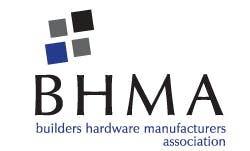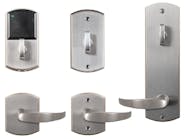A variety of specialized locks are designed for traditional use in schools on classroom doors. The Classroom Lock’s function type is unique in that the lock can only be locked or unlocked from outside the classroom by using a key (usually held by the teacher, administrators and custodians). Since this type of lock must be locked from outside the room, it is intended to make it difficult for mischievous students to lock the teacher – or other authority figures – out of the classroom from the inside.
Following the tragic events of Columbine High School in 1999, the classroom intruder lock was designed to allow a teacher to lock the classroom door with a key from the outside or the inside of a classroom. As this type of lock allows the teacher to use a key from inside the classroom to lock the outside lever (with the door closed), it can prevent unauthorized ingress through the classroom door—a functionality which can be important in the event of an emergency.
As the number of shootings has increased over the past two decades, some schools have decided to use entrance locks for classroom doors. Entrance locks allow any occupant – not just the teacher – to lock the door from inside the classroom using a button or thumb turn. Like the classroom intruder lock, these locks can be unlocked from the outside using a key or credential. Since entrance locks allow any person within the classroom to lock the door at any time, however, there is a greater risk of them being misused – by a troublesome student, perhaps – to potentially lock out authorized personnel.
Needless to say, parents, teachers and school personnel have struggled to figure out the best way to protect students and staff in the event of an active shooter. In some cases, these parties feel that classroom intruder locks and entrance locks aren’t adequate when it comes to keeping their students safe. As a result, ad hoc devices—such as door barricade devices —have emerged over the last few years. These ad hoc devices are typically designed to be deployed on classroom doors (in addition to the existing locking hardware) in the event of a lockdown or active shooter situation. Door barricade devices are currently being made available to—and installed by—some school districts despite the fact that they may violate building codes, fire codes, life safety codes and accessibility laws. Consequently, building code and fire code officials across the country are being challenged with the task of determining an appropriate compromise between life safety and security when it comes to schools.
The Controversy
Commercial locksets, like classroom, intruder, and entrance locks, are designed to meet building, fire and life safety code requirements for free egress, which means they always allow occupants to exit a room without impediment. These commercial locksets also meet accessibility requirements set forth by the Americans with Disabilities Act (ADA). These types of locksets have been proven to effectively secure classrooms against active shooters; in fact, testimony presented to the Sandy Hook Advisory Commission—a 16-member panel of experts established as a result of the 2012 mass shooting at Sandy Hook Elementary in Newton, CT—indicated that an active shooter has never breached a locked classroom door.
Building codes, fire codes, life safety codes and the ADA ensure safe egress and easy access for all by requiring door hardware in public and commercial buildings to have single-operation release for easy egress. This means that locks must not require any keys, tools, special knowledge or effort to unlock. Door hardware also must not require tight grasping, pinching or twisting of the wrist.
Door barricade devices and other gadgets often violate these codes and regulations, life safety codes and the ADA because they tend to require multiple steps and/or “special knowledge” for operation, delaying egress. These inconsistencies may compromise fire safety, and have the potential to create an environment where disabled employees and students are discriminated against because of their inability to operate the barricade device. Yet, some argue that, since door barricades are only intended to be used in a shooter situation, the ability to secure the door takes precedence over building code, fire code and life safety code requirements.
Types of Ad Hoc Devices
Some door barricade devices attach to the door just above floor, using the strength of the floor to withstand extreme force in an attempted entry. Other barricade devices are bar-shaped, and are fastened in one of two ways: against the bottom of the door using the door frames, or against the middle of the door using the door handle and door frame. Another type of barricade device—known as a “sleeve”—is a triangle-shaped, metal wedge that fits around the door's closer arm, preventing the arms of the closer from spreading and thereby securing the door from the inside.
While these devices may seem to provide better security by preventing or delaying ingress to classrooms, door barricade devices facilitate unauthorized use in rooms where they are readily available. If a door barricade device is used by someone intending to harm others, these devices can especially be hazardous to life safety. Many ad hoc door barricade devices are difficult for authorized personnel outside of the room to remove or disengage, and may require significant physical force to breach the door. When installed, door barricade devices can also make it harder for people to leave a room in life-threatening situations; should there be a fire or an intruder already within the classroom, for example. Furthermore, these devices are also more difficult for smaller children, the elderly or those with disabilities to operate than conventional locksets. So, while ad hoc door barricade devices may help people feel safer by allowing them to barricade themselves inside a classroom during an emergency, most of these devices introduce unintended risks that far outweigh their intended benefit.
Recommendations
When it comes to school security—and security in general—it is always recommended to use locking systems that comply with building codes, fire codes, life safety codes and accessibility laws. Classroom locking hardware certified by the Builders Hardware Manufacturers Association (BHMA) offers safe and reliable solutions, as they comply with all codes and follow the requirements set forth by the ADA.
In addition to typical mechanical classroom and intruder locks, electric locking designs are available and are also recommended, since they can be controlled from a distance by teachers, administrators or other authorized personnel to secure classrooms in the event of a lockdown. As previously mentioned, another possible alternative is the entrance lock, though this function is not highly recommended for classroom applications since they are much easier for unauthorized persons to misuse.
Building codes do not specify which of these hardware options should be used within schools; instead, it is up to local decision makers to decide on a case-by-case basis. Why? Because the kind of lock function desired can vary by school type (elementary school, middle school, high school or college) and room type (classroom, office, library, etc.), in addition to other considerations.
Next Steps
To help address these life safety issues, BHMA is working with other stakeholders to provide information about the risks of some ad hoc door barricade devices and to review and revise building codes, fire codes and life safety codes. In fact, language has already been approved to be added to the 2018 International Building Code (IBC), as follows:
1010.1.4.4 – Locking arrangements in educational occupancies. In Group E and Group B educational occupancies, egress doors from classrooms, offices and other occupied rooms shall be permitted to be provided with locking arrangements designed to keep intruders from entering the room where all of the following conditions are met:
- The door shall be capable of being unlocked from outside the room with a key or other approved means.
- The door shall be openable from within the room in accordance with Section 1010.1.9.
- Modifications shall not be made to listed panic hardware, fire door hardware or door closers.
1010.1.4.4.1 – Remote operation of locks. Remote operation of locks complying with Section 1010.1.4.4 shall be permitted.
This language will apply to all K-12, college and university classrooms, as well as offices and other occupied rooms. The codes will now clearly state that, if these types of rooms are lockable, they must be able to be unlocked from outside the room, and must comply with all the existing requirements of the IBC.
Similar language will also receive final approval this year for the 2018 International Fire Code (IFC):
1031.2.2 Locking arrangements in educational occupancies. In Group E occupancies, Group B educational occupancies and Group I-4 child day care occupancies, egress doors from classrooms, offices and other occupied rooms shall be permitted to be provided with locking arrangements designed to keep intruders from entering the room where all of the following conditions are met:
- The door shall be capable of being unlocked from outside the room with a key or other approved means.
- The door shall be openable from within the room in accordance with Section 1010.1.9.
- Modifications shall not be made to existing listed panic hardware, fire door hardware or door closers.
- Modifications to fire door assemblies shall be in accordance with NFPA 80.
Additionally, new language for NFPA 101: Life Safety Code is expected to be approved by the end of summer 2017.
John Woestman is Director of Codes and Government Affairs, BHMA. For more information, visit www.buildershardware.com.





